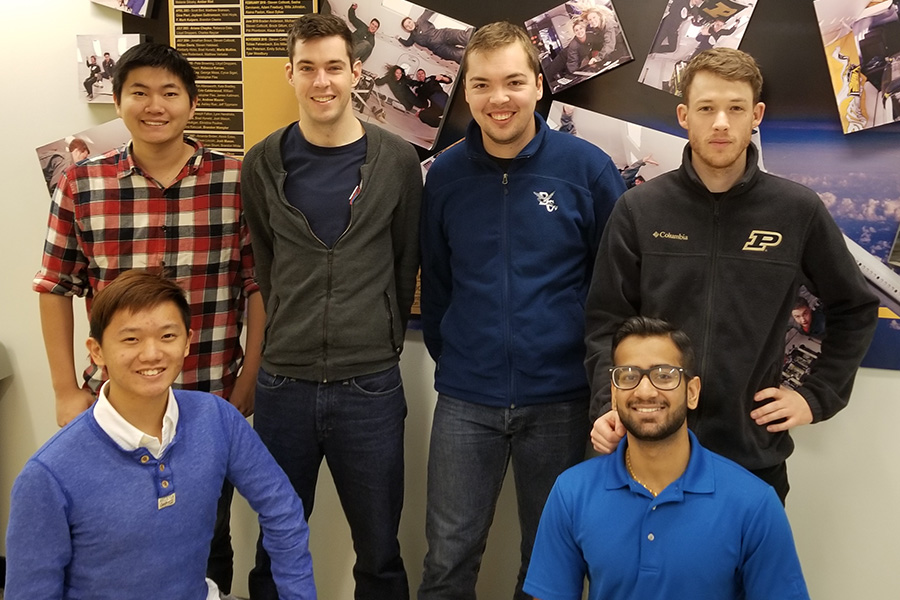Team of undergraduate students selected for NASA's Micro-g NExT challenge

A team of AAE students has been selected by NASA for the 2019 Micro-g Neutral Buoyancy Experiment Design Teams (NExT) challenge and will test a tool they designed and built at Purdue in the Neutral Buoyancy Lab in Houston in the spring.
This is the fifth year of the Micro-g NExT competition, and a team from the AAE418 Zero-Gravity Flight Experiment class has had its proposal selected every year.
But there was some drama Thursday.
The six AAE undergraduate students from AAE418 on the team — Evan Lee, David Liu, George Mitchel, Philippe Panten, Anchit Rout, and Luca Stoll — gathered inside a conference room in Neil Armstrong Hall to watch the announcement, broadcast live on NASA’s Johnson Space Center’s Facebook page. They had to wait nearly 20 minutes until hearing they’d been selected: The team was the final one announced.
But when the Facebook feed cut to NASA’s Rocket Park and a shot of Tyler Duncan, an alumnus wearing a shirt with a Purdue logo and standing in front of Saturn V, the students inside the conference room started cheering. They slapped high fives. They released audible sighs of relief.
They didn’t actually hear anything Duncan had to say — they rewatched that part of the feed later — but they knew they were in after seeing the logo on his shirt and, then, seeing “Purdue University” pop up on a graphic at the bottom of the feed.
“It honestly was very nerve-wracking, being the last team to be shown to be chosen. It definitely kept us on our toes,” says Liu, a senior in AAE. “It means a lot that we’re keeping the streak alive, but we’re hoping we’ll be able to show that our tool is different and more effective than that of other teams. I know there were a lot of other teams doing the same tool, each of them with their own design. We’re out there to prove that Purdue is still the best and the most innovative in terms of ideas and products.”
This year’s challenge asked undergraduate students to design, build and test a tool or device that addressed International Space Station spacewalking needs. Specifically, the challenges included sharp edge detection and removal/covering, EVA camera attachment mechanism, and mini-arm end-effector. The Purdue students chose the spacewalk camera attachment tool design challenge and are building one device that mounts to three different types of hand rails that astronauts encounter outside the ISS during spacewalks.
“The students created a practical design that meets all of the requirements imposed by NASA and is also quite simple to actuate by a gloved hand to attach to the three different rails,” says AAE Professor Steven Collicott, who teaches the class with David Wolf. “I am reminded each year how cool it is that our Purdue aerospace engineering students are taught by Professor Wolf, who performed many successful spacewalks on Space Shuttle, Mir, and the International Space Station.”
Purdue’s team will visit NASA’s Neutral Buoyancy Lab, which has a 6.2-million-gallon pool to train astronauts for spacewalks, to test their tool with professional NBL divers. The students coach the divers and then direct the divers from the Test Conductor Room of the NBL facility. The anticipated test weeks are May 20-25 and June 3-8.
